Statistical Measurements and Club Effects of High-Quality Development in Chinese Manufacturing
Abstract
1. Introduction
2. Materials and Methods
2.1. Two-Stage Entropy Method
2.2. Club Convergence Test Method
2.2.1. Convergence Tests of Nonlinear, Time-Varying Factor Models
2.2.2. Club Clustering
- Sorting
- 2.
- Select core group
- 3.
- Add provinces.
- 4.
- Stop algorithm
2.2.3. Club Integration
2.3. Data Source and Processing
3. Results
3.1. Measurement of HQDM in China
3.1.1. Constructing the Index System
- Innovation-driven.
- 2.
- Quality-first.
- 3.
- Green development.
- 4.
- Structural optimization.
- 5.
- Talent-based.
3.1.2. Measurement Results
3.2. Club Convergence Analysis of HQDM in China
3.2.1. National and Traditional Club Area Convergence Results
3.2.2. Club Convergence Test and Integration Test
3.2.3. Relative Transfer Path Results for Each Convergence Club
3.3. Factors Influencing Club Convergence
3.3.1. Variable Selection
3.3.2. Model Setting
3.3.3. Empirical Results
4. Discussion
5. Conclusions, Recommendations, and Outlook
5.1. Conclusions
5.2. Recommendations
5.3. Outlook
Author Contributions
Funding
Institutional Review Board Statement
Informed Consent Statement
Data Availability Statement
Conflicts of Interest
References
- Chen, Y.; Lin, B. Understanding the green total factor energy efficiency gap between regional manufacturing-insight from infrastructure development. Energy 2021, 237, 121553. [Google Scholar] [CrossRef]
- Wang, H.; Li, B. Environmental regulations, capacity utilization, and high-quality development of manufacturing: An analysis based on Chinese provincial panel data. Sci. Rep. 2021, 11, 19566. [Google Scholar] [CrossRef] [PubMed]
- Desli, E.; Gkoulgkoutsika, A. World economic convergence: Does the estimation methodology matter? Econ. Model. 2020, 91, 138–147. [Google Scholar] [CrossRef]
- Bai, C.; Yan, H.; Yin, S.; Feng, C.; Wei, Q. Exploring the development trend of internet finance in China: Perspective from club convergence. N. A. Econ. Financ. 2021, 58, 101505. [Google Scholar] [CrossRef]
- Xu, S.; Wu, T.; Zhang, Y. The spatial-temporal variation and convergence of green innovation efficiency in the Yangtze River Economic Belt in China. Environ. Sci. Pollut. Res. 2020, 27, 26868–26881. [Google Scholar] [CrossRef]
- Mendoza, O.V.; Borsi, M.T.; Comim, F. Human capital dynamics in China: Evidence from a club convergence approach. J. Asian Econ. 2022, 79, 101441. [Google Scholar] [CrossRef]
- Apergis, N.; Payne, J.E. Per capita carbon dioxide emissions across, U.S. states by sector and fossil fuel source: Evidence from club convergence tests. Energy Econ. 2017, 63, 365–372. [Google Scholar] [CrossRef]
- Zhuang, W.; Wang, Y.; Lu, C.-C.; Chen, X. The green total factor productivity and convergence in China. Energy Sci. Eng. 2022, 10, 2794–2807. [Google Scholar] [CrossRef]
- Bhattacharya, M.; Inekwe, J.N.; Sadorsky, P.; Saha, A. Convergence of energy productivity across Indian states and territories. Energy Econ. 2018, 74, 427–440. [Google Scholar] [CrossRef]
- Harris, R.I.D.; Trainor, M. Manufacturing industries in Northern Ireland and Great Britain: Was there convergence during the 1949-92 period? Appl. Econ. 1999, 31, 1573–1580. [Google Scholar] [CrossRef]
- Economidou, C.; Bos, J.W.B.; Koetter, M. Technology clubs, R&D and growth patterns: Evidence from EU manufacturing. Eur. Econ. Rev. 2010, 54, 60–79. [Google Scholar]
- Bianco, S.D. Going clubbing in the eighties: Convergence in manufacturing sectors at a glance. Empir. Econ. 2016, 50, 623–659. [Google Scholar] [CrossRef]
- Parker, S.; Liddle, B. Analysing energy productivity dynamics in the OECD manufacturing sector. Energy Econ. 2017, 67, 91–97. [Google Scholar] [CrossRef]
- Cialani, C.; Mortazavi, R. Sectoral analysis of club convergence in EU countries CO2 emissions. Energy 2021, 235, 121332. [Google Scholar] [CrossRef]
- Stergiou, E.; Kounetas, K.E. Eco-efficiency convergence and technology spillovers of European industries. J. Environ. Manag. 2021, 283, 111972. [Google Scholar] [CrossRef] [PubMed]
- Liu, D. Convergence of energy carbon emission efficiency: Evidence from manufacturing sub-sectors in China. Environ. Sci. Pollut. Res. 2022, 29, 31133–31147. [Google Scholar] [CrossRef]
- Yang, C.; Liu, L.; Wang, Z.; Liu, L. Convergence or divergence? The effects of economic openness on low-carbon innovation in Chinese manufacturing industry. Environ. Sci. Pollut. Res. 2021, 29, 14889–14902. [Google Scholar] [CrossRef]
- Erban, A.C.; Pelinescu, E.; Dospinescu, A.S. Beta convergence analysis of gross value added in the high-technology manufacturing industries. Technol. Econ. Dev. Econ. 2021, 28, 290–312. [Google Scholar] [CrossRef]
- Sul, P.D. Transition Modeling and Econometric Convergence Tests. Econometrica 2007, 75, 1771–1855. [Google Scholar]
- Huang, J.; Yu, Y.; Ma, C. Energy Efficiency Convergence in China: Catch-Up, Lock-In and Regulatory Uniformity. Environ. Resour. Econ. 2018, 70, 107–130. [Google Scholar] [CrossRef]
- Cheong, T.S.; Li, V.J.; Shi, X. Regional disparity and convergence of electricity consumption in China: A distribution dynamics approach. China Econ. Rev. 2018, 58, 101154. [Google Scholar] [CrossRef]
- Zhu, J.; Lin, B. Convergence analysis of city-level energy intensity in China. Energy Policy 2020, 139, 111357. [Google Scholar] [CrossRef]
- Bartkowska, M.; Riedl, A. Regional convergence clubs in Europe: Identification and conditioning factors. Econ. Model. 2012, 29, 22–31. [Google Scholar] [CrossRef]
- Bai, C.; Feng, C.; Du, K.; Wang, Y.; Gong, Y. Understanding spatial-temporal evolution of renewable energy technology innovation in China: Evidence from convergence analysis. Energy Policy 2020, 143, 111570. [Google Scholar]
- Kijek, T.; Kijek, A.; Matras-Bolibok, A. Club Convergence in R&D Expenditure across European Regions. Sustainability 2022, 14, 832. [Google Scholar]
- Herrerías, M.J.; Ordoñez, J. New evidence on the role of regional clusters and convergence in China (1952–2008). China Econ. Rev. 2012, 23, 1120–1133. [Google Scholar] [CrossRef]
- Huang, J.; Butsic, V.; He, W.; Degefu, D.M.; Liao, Z.; An, M. Historical Accountability for Equitable, Efficient, and Sustainable Allocation of the Right to Emit Wastewater in China. Entropy 2018, 20, 950. [Google Scholar] [CrossRef]
- Tang, D.; Wang, L.; Bethel, B.J. An Evaluation of the Yangtze River Economic Belt Manufacturing Industry Level of Intelligentization and Influencing Factors: Evidence from China. Sustainability 2021, 13, 8913. [Google Scholar] [CrossRef]
- Phillips, P.; Sul, D. Economic Transition and Growth. J. Appl. Econom. 2009, 24, 1153–1185. [Google Scholar] [CrossRef]
- Zhang, D.; Broadstock, D.C. Club convergence in the energy intensity of China. Energy J. 2016, 37, 137–158. [Google Scholar] [CrossRef]
- Lucas Robert, E. On the mechanics of economic development. J. Monetary Econ. 1988, 22, 3–42. [Google Scholar] [CrossRef]
- Wang, M.; Yu, D.; Chen, H.; Li, Y. Comprehensive Measurement, Spatiotemporal Evolution, and Spatial Correlation Analysis of High-Quality Development in the Manufacturing Industry. Sustainability 2022, 14, 5807. [Google Scholar] [CrossRef]
- Pan, W.; Wang, J.; Lu, Z.; Liu, Y.; Li, Y. High-quality development in China: Measurement system, spatial pattern, and improvement paths. Habitat Int. 2021, 118, 102458. [Google Scholar] [CrossRef]
- Zhou, B.; Wang, N.; Zhang, Z.; Liu, W.; Lu, W.; Xu, R.; Li, L. Research on the Spatial-Temporal Differentiation and Path Analysis of China’s Provincial Regions’ High-Quality Economic Development. Sustainability 2022, 14, 6348. [Google Scholar] [CrossRef]
- Fan, C.C.; Scott, A.J. Industrial Agglomeration and Development: A Survey of Spatial Economic Issues in East Asia and a Statistical Analysis of Chinese Regions. Econ. Geogr. 2003, 79, 295–319. [Google Scholar] [CrossRef]
- Porter, M.E. America’s Green Strategy. Sci. Am. 1991, 264, 193–246. [Google Scholar]
- Testa, F.; Iraldo, F.; Frey, M. The effect of environmental regulation on firms’ competitive performance: The case of the building & construction sector in some EU regions. J. Environ. Manag. 2011, 92, 2136–2144. [Google Scholar]
- Rubashkina, Y.; Galeotti, M.; Verdolini, E. Environmental regulation and competitiveness: Empirical evidence on the Porter Hypothesis from European manufacturing sectors. Energy Policy 2015, 83, 288–300. [Google Scholar] [CrossRef]
- Cheng, M.; Shao, Z.; Yang, C.; Tang, X. Analysis of Coordinated Development of Energy and Environment in China’s Manufacturing Industry under Environmental Regulation: A Comparative Study of Sub-Industries. Sustainability 2019, 11, 6510. [Google Scholar] [CrossRef]
- Ouyang, X.; Li, Q.; Du, K. How does environmental regulation promote technological innovations in the industrial sector? Evidence from Chinese provincial panel data. Energy Policy 2020, 139, 111310. [Google Scholar] [CrossRef]
- Andersson, L. Openness and total factor productivity in Swedish manufacturing 1980–1995. Weltwirtsch. Arch.-Rev. World Econ. 2001, 137, 690–713. [Google Scholar] [CrossRef]
- Liddle, B.T. Privatization Decision and Civil Engineering Projects. J. Manag. Eng. 1997, 13, 73–78. [Google Scholar] [CrossRef]
- Brzić, B.; Dabić, M.; Kukura, F.; Podobnik, B. The effects of corruption and the fraction of private ownership on the productivity of telecommunication companies. Technol. Soc. 2021, 65, 101532. [Google Scholar] [CrossRef]
- Zhu, M.; Camp, R.C.; Ashamalla, M. Comparison of Entrepreneurship Environment for Executives between State-owned and Private Enterprises in China. China World Econ. 2007, 15, 17. [Google Scholar] [CrossRef]
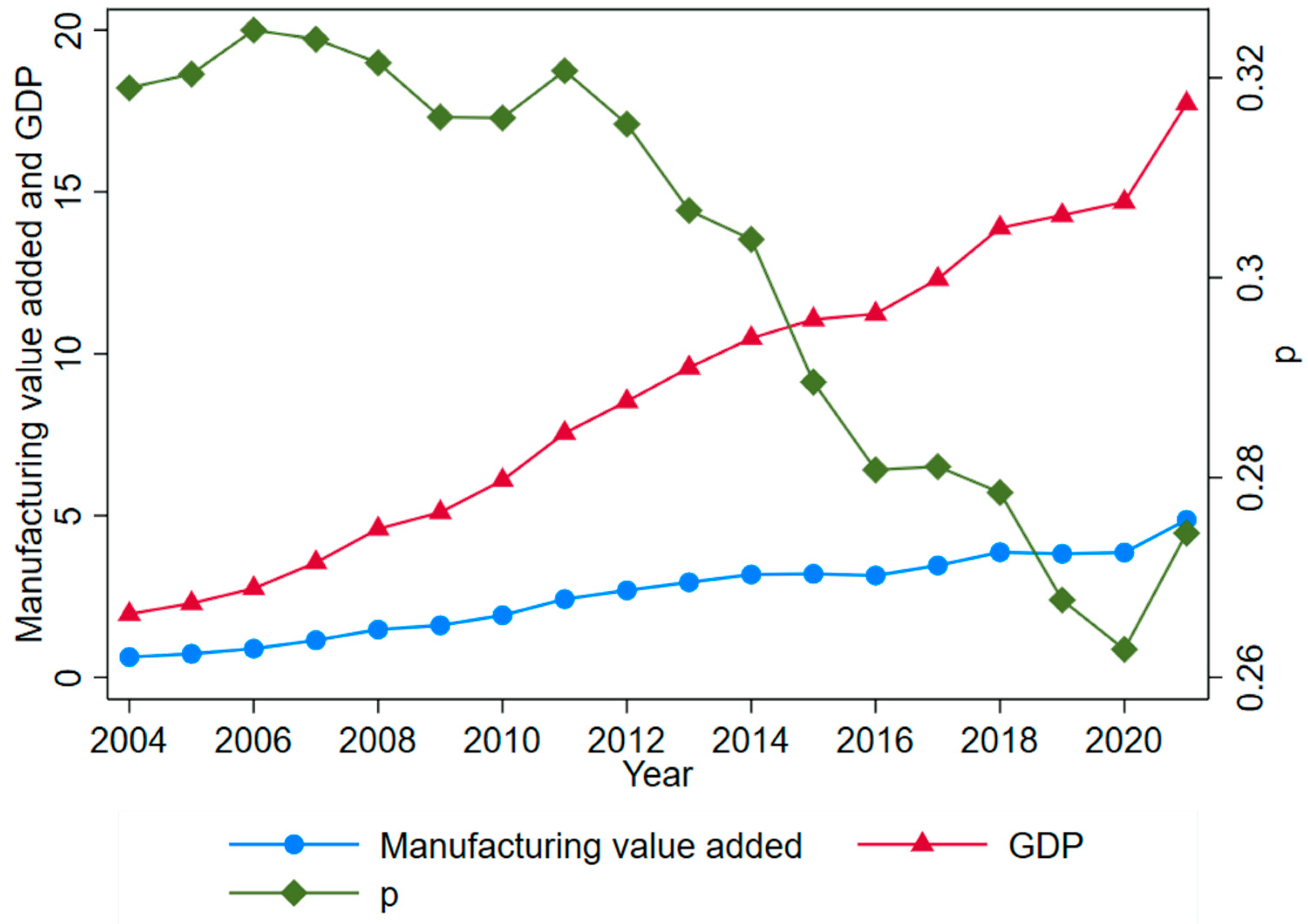
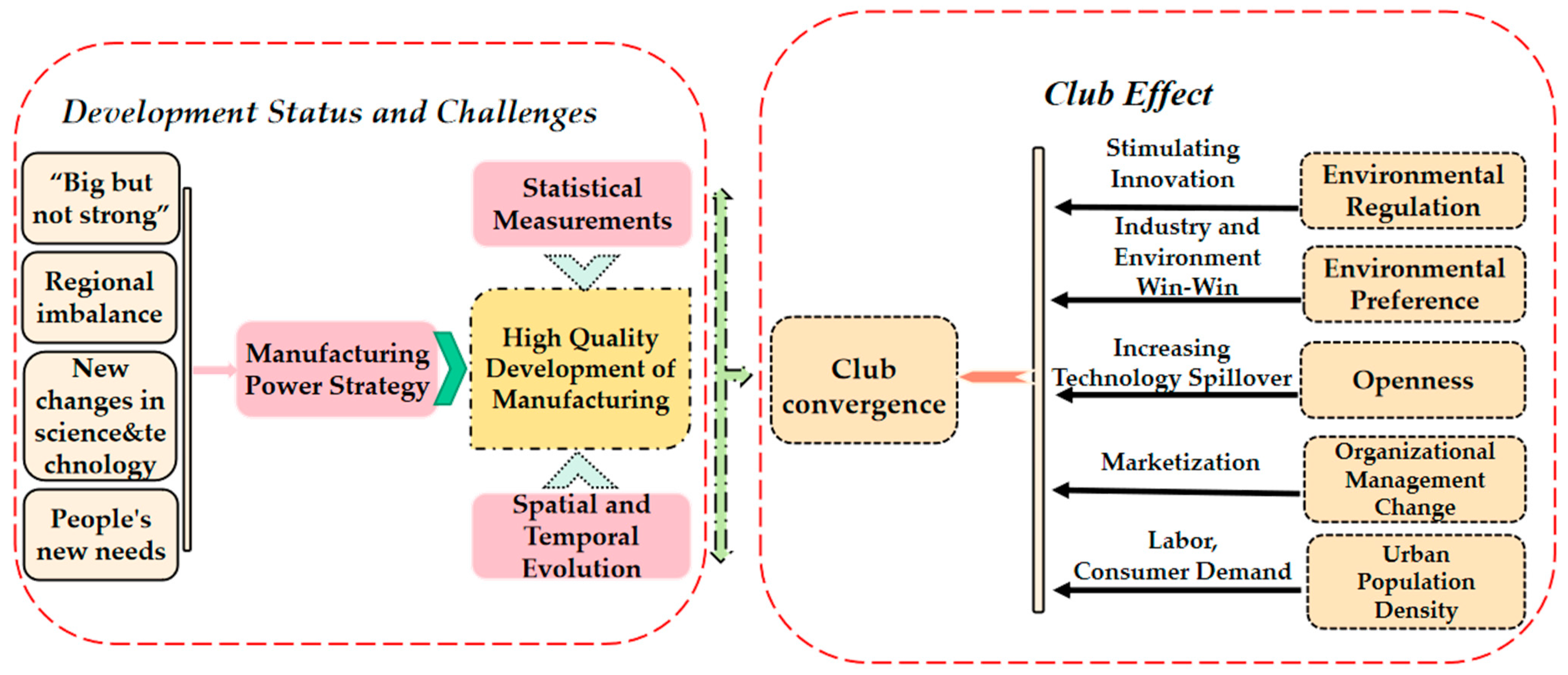
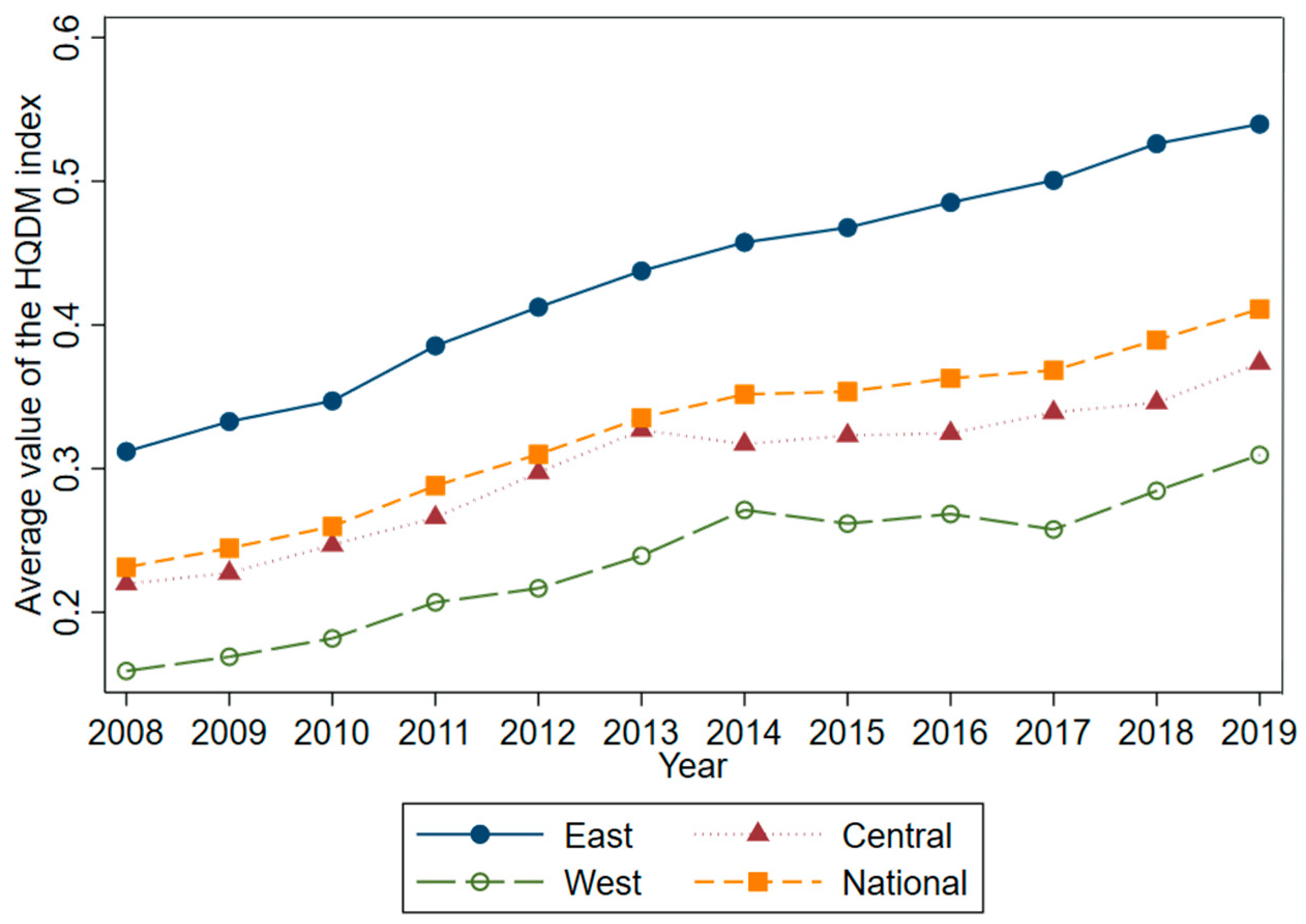
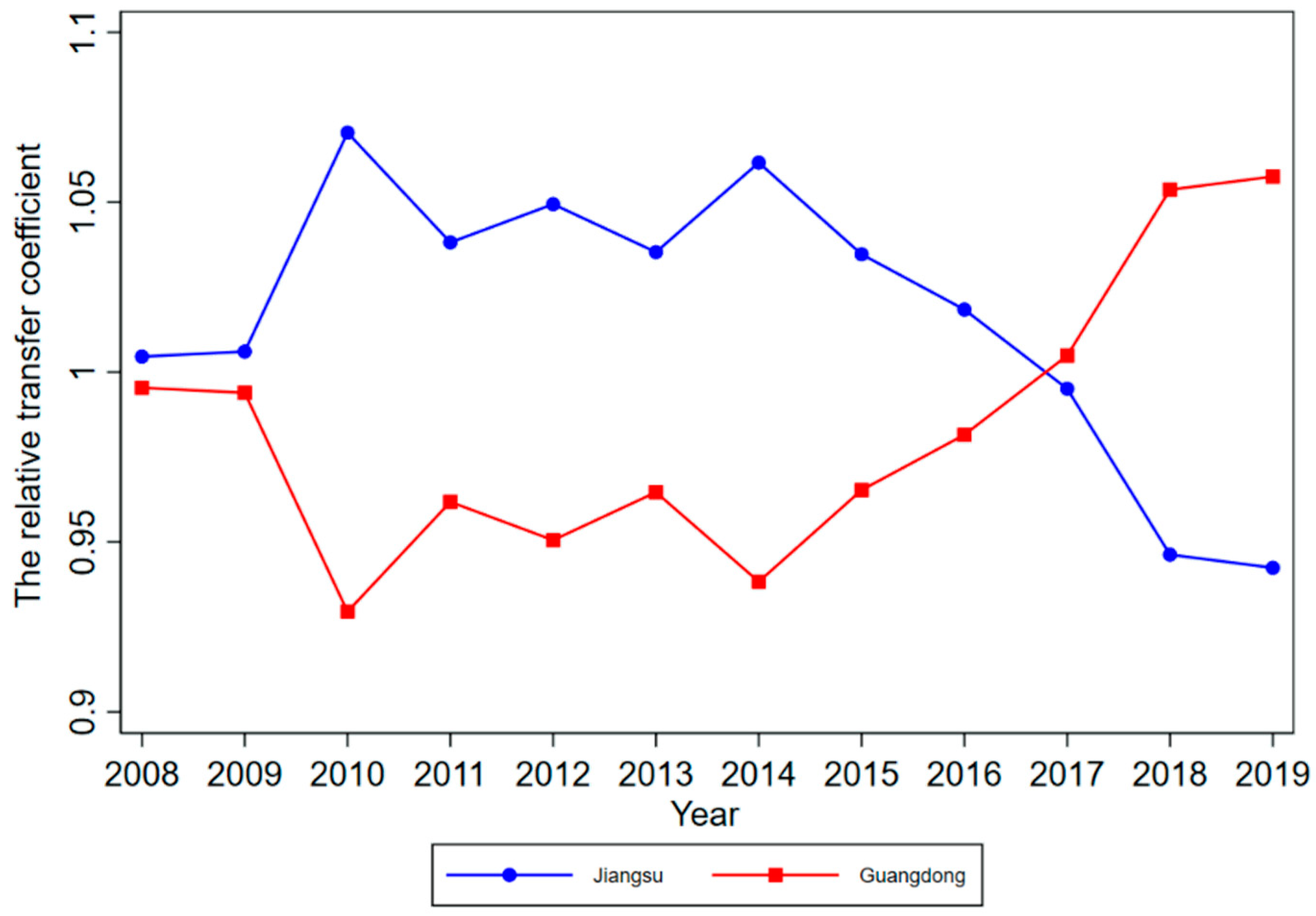
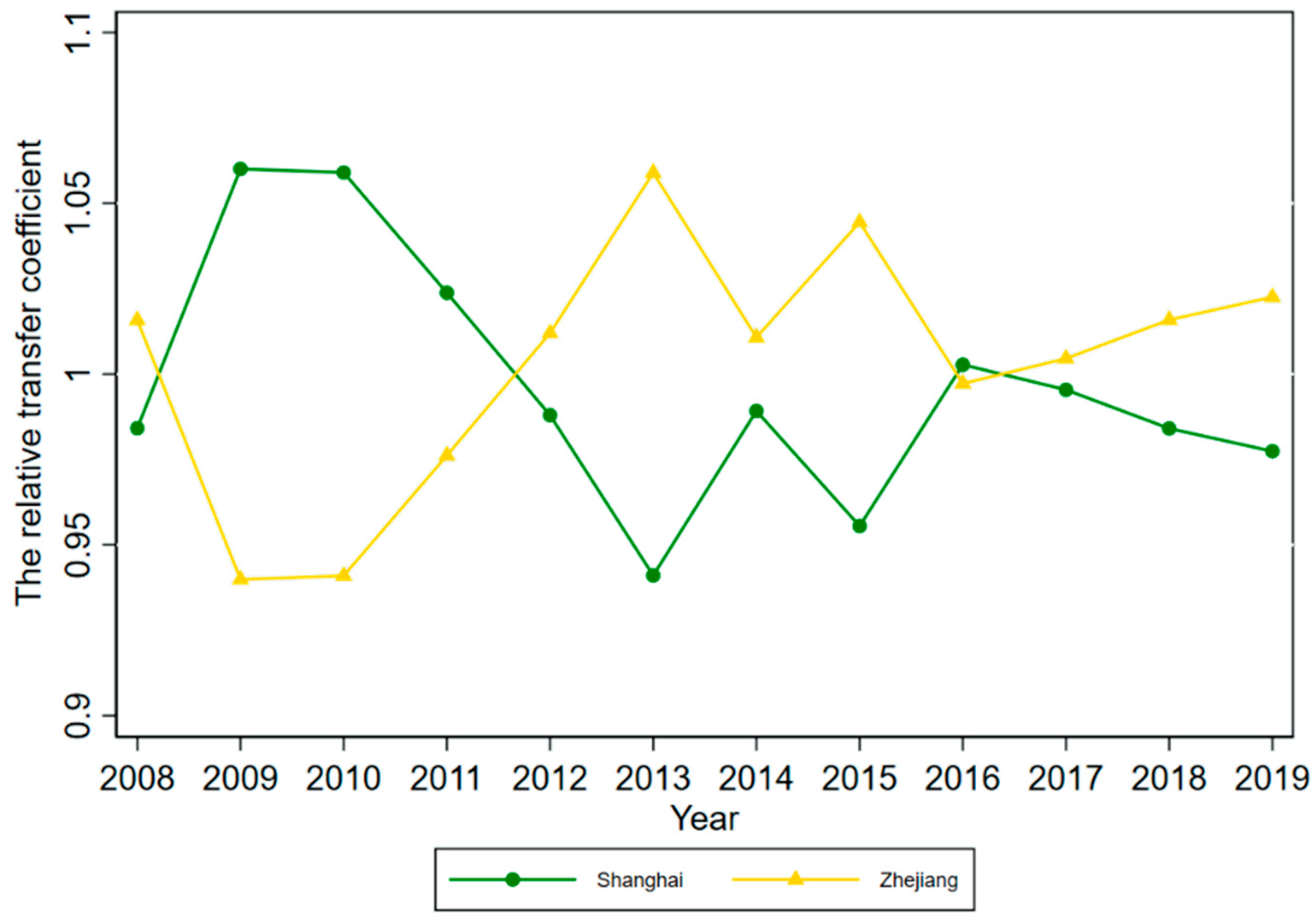
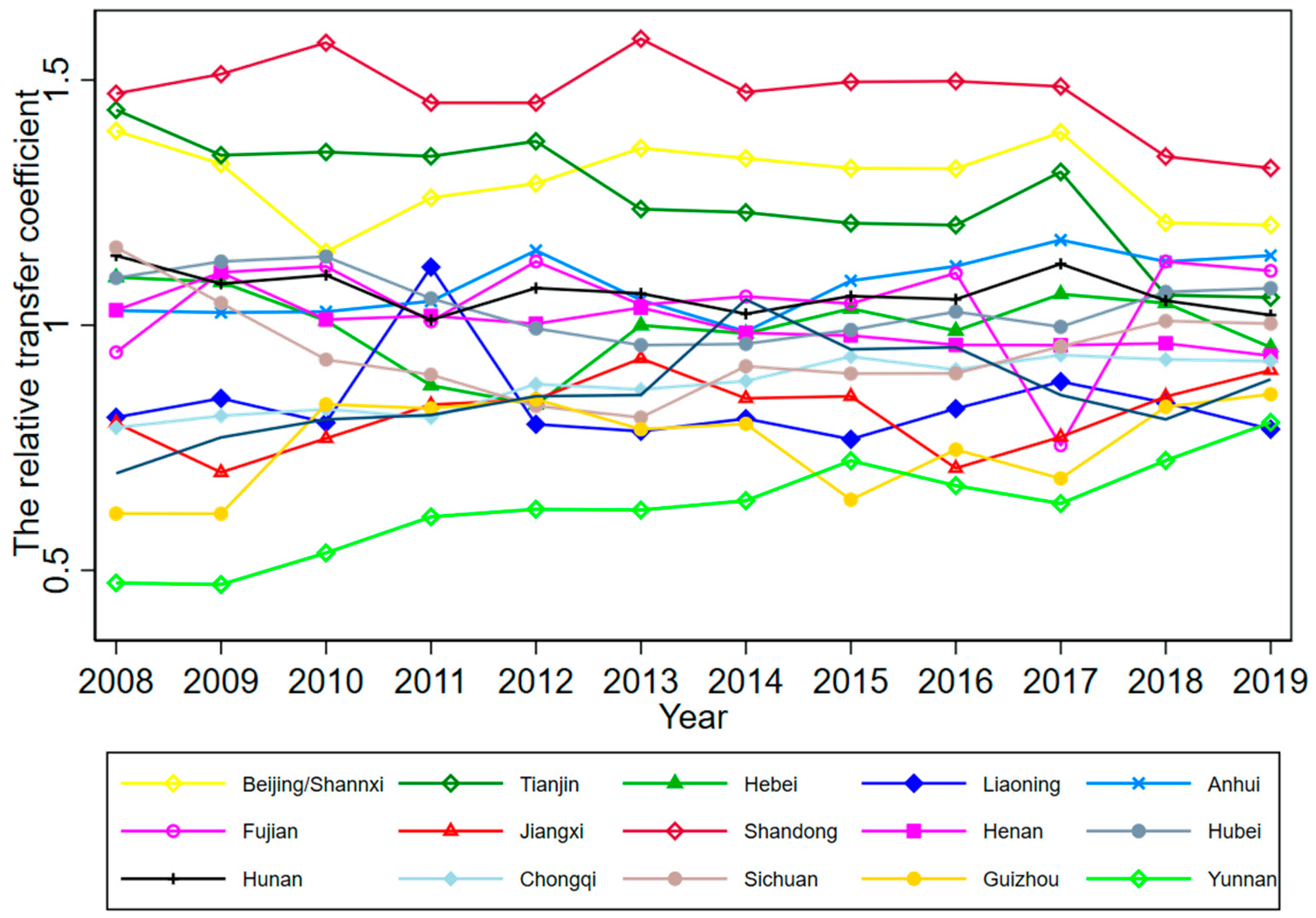
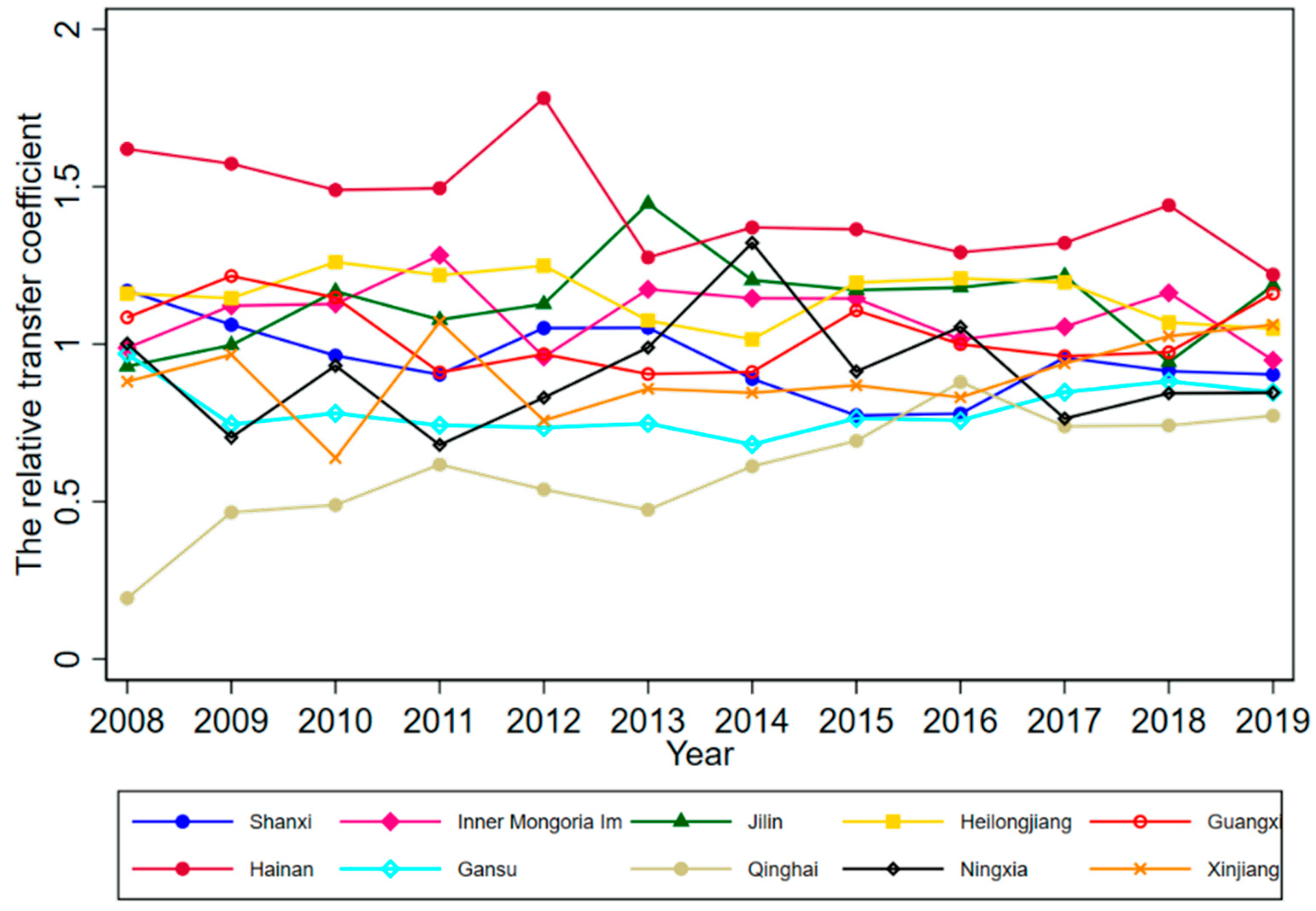
| Tier 1 Indicators | Secondary Indicators | Indicator Description | Properties | Variable Name |
|---|---|---|---|---|
| Innovation-driven | R&D input | R&D expenditure | + | X1 |
| New product development input | Expenses for new product development | + | X2 | |
| Number of R&D institutions | Number of R&D institutions opened | + | X3 | |
| R&D institutional input | Expenses for setting up R&D institutions | + | X4 | |
| R&D output | Number of R&D projects | + | X5 | |
| New product project output | Number of new product development projects | + | X6 | |
| Benefits of new products | Revenue from sales of new products | + | X7 | |
| Patent output | Number of valid invention patents | + | X8 | |
| Technical Contribution | Contract turnover of technology market | + | X9 | |
| Quality-first | Total labor productivity | Industrial value added/Average number of all employees | + | X10 |
| Technology introduction | Expenditure on digestion and absorption of introduced technologies | + | X11 | |
| Equipment transformation | Expenditures for technological transformation | + | X12 | |
| Brand value level | Brand value/Industrial value added | + | X13 | |
| Product quality level | Superiority rate | + | X14 | |
| Product Sales | Product sales rate | + | X15 | |
| Green development | Comprehensive utilization rate of industrial solid waste | Comprehensive utilization of solid waste/Generation of solid waste | + | X16 |
| Investment intensity of pollution control | The amount of investment completed in industrial pollution control/Industrial value added | + | X17 | |
| Wastewater treatment | Industrial wastewater treatment facilities treatment capacity | + | X18 | |
| Energy consumption per unit of industrial value added | Total energy consumption/Industrial value added | - | X19 | |
| Structural optimization | Intelligent manufacturing | Number of broadband Internet access ports | + | X20 |
| Level of informatization | Mobile phone subscribers | + | X21 | |
| Development of new products in high-end industries | Number of new product development projects in high-tech industry/Number of industrial new product development projects% | + | X22 | |
| Intensity of technological transformation of high-end industries | Expenditure for technological transformation of high-tech industries/Expenditure for technical transformation% | + | X23 | |
| Talent-based | Talent input intensity | Full-time equivalent R&D personnel/Number of Employees | + | X24 |
| Treatment of talent | Average wage of manufacturing workers | + | X25 | |
| Talent intelligence level | Number of doctorates and masters in R&D institutions run by enterprises | + | X26 |
| Province | 2008 | 2009 | 2010 | 2011 | 2012 | 2013 | 2014 | 2015 | 2016 | 2017 | 2018 | 2019 | Average Annual Growth Rate (%) |
|---|---|---|---|---|---|---|---|---|---|---|---|---|---|
| Beijing | 0.331 | 0.326 | 0.306 | 0.369 | 0.398 | 0.465 | 0.481 | 0.477 | 0.484 | 0.522 | 0.488 | 0.508 | 3.967 |
| Tianjin | 0.341 | 0.330 | 0.360 | 0.393 | 0.425 | 0.423 | 0.441 | 0.436 | 0.442 | 0.492 | 0.428 | 0.445 | 2.456 |
| Hebei | 0.260 | 0.267 | 0.269 | 0.257 | 0.259 | 0.342 | 0.353 | 0.373 | 0.363 | 0.398 | 0.421 | 0.402 | 4.048 |
| Shanxi | 0.198 | 0.193 | 0.179 | 0.190 | 0.249 | 0.262 | 0.233 | 0.194 | 0.199 | 0.236 | 0.227 | 0.243 | 1.898 |
| Inner Mongolia | 0.167 | 0.204 | 0.210 | 0.270 | 0.227 | 0.292 | 0.299 | 0.287 | 0.260 | 0.260 | 0.288 | 0.255 | 3.933 |
| Liaoning | 0.192 | 0.208 | 0.213 | 0.327 | 0.247 | 0.268 | 0.290 | 0.277 | 0.305 | 0.332 | 0.339 | 0.332 | 5.085 |
| Jilin | 0.157 | 0.181 | 0.217 | 0.227 | 0.267 | 0.360 | 0.315 | 0.294 | 0.302 | 0.299 | 0.234 | 0.319 | 6.652 |
| Heilongjiang | 0.196 | 0.208 | 0.234 | 0.256 | 0.296 | 0.268 | 0.265 | 0.300 | 0.309 | 0.295 | 0.265 | 0.282 | 3.364 |
| Shanghai | 0.323 | 0.388 | 0.409 | 0.424 | 0.434 | 0.424 | 0.486 | 0.493 | 0.548 | 0.560 | 0.577 | 0.614 | 6.034 |
| Jiangsu | 0.404 | 0.437 | 0.483 | 0.535 | 0.582 | 0.621 | 0.646 | 0.667 | 0.695 | 0.733 | 0.749 | 0.773 | 6.071 |
| Zhejiang | 0.333 | 0.344 | 0.364 | 0.405 | 0.444 | 0.477 | 0.496 | 0.539 | 0.545 | 0.565 | 0.596 | 0.643 | 6.164 |
| Anhui | 0.244 | 0.251 | 0.274 | 0.307 | 0.356 | 0.359 | 0.354 | 0.394 | 0.411 | 0.440 | 0.456 | 0.481 | 6.370 |
| Fujian | 0.224 | 0.271 | 0.298 | 0.295 | 0.349 | 0.356 | 0.380 | 0.377 | 0.406 | 0.283 | 0.456 | 0.468 | 6.938 |
| Jiangxi | 0.190 | 0.171 | 0.205 | 0.245 | 0.262 | 0.319 | 0.305 | 0.309 | 0.260 | 0.289 | 0.345 | 0.383 | 6.587 |
| Shandong | 0.349 | 0.370 | 0.420 | 0.425 | 0.449 | 0.542 | 0.529 | 0.540 | 0.550 | 0.557 | 0.542 | 0.556 | 4.336 |
| Henan | 0.244 | 0.271 | 0.269 | 0.298 | 0.310 | 0.354 | 0.353 | 0.354 | 0.352 | 0.359 | 0.388 | 0.395 | 4.475 |
| Hubei | 0.260 | 0.277 | 0.304 | 0.309 | 0.307 | 0.328 | 0.345 | 0.358 | 0.377 | 0.373 | 0.431 | 0.453 | 5.188 |
| Hunan | 0.271 | 0.266 | 0.293 | 0.296 | 0.332 | 0.364 | 0.367 | 0.383 | 0.386 | 0.422 | 0.423 | 0.430 | 4.306 |
| Guangdong | 0.400 | 0.432 | 0.419 | 0.496 | 0.527 | 0.578 | 0.571 | 0.623 | 0.670 | 0.740 | 0.835 | 0.867 | 7.278 |
| Guangxi | 0.183 | 0.221 | 0.213 | 0.192 | 0.229 | 0.225 | 0.238 | 0.278 | 0.256 | 0.237 | 0.241 | 0.312 | 4.956 |
| Hainan | 0.274 | 0.286 | 0.277 | 0.315 | 0.422 | 0.318 | 0.358 | 0.342 | 0.330 | 0.325 | 0.357 | 0.328 | 1.666 |
| Chongqing | 0.187 | 0.200 | 0.221 | 0.237 | 0.272 | 0.297 | 0.318 | 0.338 | 0.334 | 0.352 | 0.375 | 0.391 | 6.904 |
| Sichuan | 0.275 | 0.256 | 0.248 | 0.263 | 0.258 | 0.278 | 0.329 | 0.326 | 0.331 | 0.358 | 0.407 | 0.423 | 4.004 |
| Guizhou | 0.146 | 0.151 | 0.223 | 0.243 | 0.262 | 0.269 | 0.286 | 0.233 | 0.274 | 0.258 | 0.336 | 0.362 | 8.616 |
| Yunnan | 0.112 | 0.115 | 0.143 | 0.178 | 0.193 | 0.213 | 0.230 | 0.261 | 0.247 | 0.238 | 0.292 | 0.338 | 10.524 |
| Shaanxi | 0.165 | 0.189 | 0.215 | 0.239 | 0.264 | 0.293 | 0.378 | 0.343 | 0.351 | 0.321 | 0.326 | 0.375 | 7.726 |
| Gansu | 0.164 | 0.135 | 0.145 | 0.156 | 0.174 | 0.186 | 0.178 | 0.192 | 0.194 | 0.209 | 0.219 | 0.228 | 3.050 |
| Qinghai | 0.033 | 0.085 | 0.091 | 0.130 | 0.128 | 0.118 | 0.160 | 0.174 | 0.225 | 0.182 | 0.184 | 0.208 | 18.312 |
| Ningxia | 0.169 | 0.128 | 0.173 | 0.143 | 0.197 | 0.246 | 0.345 | 0.229 | 0.270 | 0.188 | 0.209 | 0.228 | 2.724 |
| Xinjiang | 0.149 | 0.176 | 0.119 | 0.225 | 0.179 | 0.214 | 0.221 | 0.218 | 0.213 | 0.231 | 0.254 | 0.286 | 6.097 |
| Test Subjects | Number of Provinces | Convergence or Not | |||
|---|---|---|---|---|---|
| National | 30 | −1.3514 | 0.1219 | −11.0874 | No |
| East | 11 | −1.6498 | 0.1378 | −11.9733 | No |
| Central | 8 | −2.7675 | 0.2483 | −11.1466 | No |
| West | 11 | −1.1212 | 0.2361 | −4.7495 | No |
| Initial Clubs | Estimated Value | Merging Test | Final Clubs | ||
|---|---|---|---|---|---|
| Club A | 0.2543 (0.1225) | Club A + B −1.2238 (−4.2839) | Club1:Club A | ||
| Club B | 0.6019 (0.2771) | Club B + C −0.7123 (−2.9357) | Club2:Club B | ||
| Club C | −0.1923 (−0.5220) | Club C + D −0.8800 (−6.3737) | Club3:Club C | ||
| Club D | 0.6068 (4.087) | Club4:Club D | |||
| Club | Average Value of HQDM Index | Characteristics | Membership |
|---|---|---|---|
| 1 | 0.6035 | High level | Guangdong, Jiangsu. |
| 2 | 0.4763 | Relatively high level | Shanghai, Zhejiang. |
| 3 | 0.3315 | Moderate level | Anhui, Beijing, Chongqing, Fujian, Guizhou, Hebei, Henan, Hubei, Hunan, Jiangxi, Liaoning, Shandong, Shaanxi, Sichuan, Tianjin, Yunnan. |
| 4 | 0.2303 | Low level | Gansu, Guangxi, Hainan, Heilongjiang, Jilin, Inner Mongolia, Ningxia, Qinghai, Shanxi, Xinjiang. |
| Variable | Obs | Mean | SD | Min | Max |
|---|---|---|---|---|---|
| ER | 30 | 65.6269 | 14.4579 | 42.8488 | 113.2422 |
| EP | 30 | 38.7243 | 3.5536 | 30.4646 | 46.8173 |
| OPEN | 30 | 27.0244 | 28.8921 | 2.5337 | 119.0657 |
| OMC | 30 | 89.5992 | 7.0538 | 73.7419 | 98.3274 |
| lnUPD | 30 | 7.8707 | 0.4039 | 7.1745 | 8.5395 |
| Variables | Coefficient | Marginal Effects | ||
|---|---|---|---|---|
| Club 1 | Club 2 | Club 3 | ||
| ER | −0.1576 *** (−2.60) | 0.0033 *** (3.04) | 0.0071 *** (2.65) | −0.0105 *** (−3.14) |
| EP | −0.2607 * (−1.95) | 0.0055 (1.61) | 0.0118 *** (3.11) | −0.0173 ** (−2.47) |
| OPEN | −0.1997 ** (−2.36) | 0.0042 *** (3.68) | 0.0091 *** (2.65) | −0.0133 *** (−3.32) |
| OMC | −0.5318 *** (−3.50) | 0.0113 *** (3.36) | 0.0241 *** (3.15) | −0.0354 *** (−3.87) |
| lnUPD | −4.8485 ** (−2.00) | 0.1026 ** (2.18) | 0.2199 ** (2.18) | −0.3225 ** (−2.36) |
Publisher’s Note: MDPI stays neutral with regard to jurisdictional claims in published maps and institutional affiliations. |
© 2022 by the authors. Licensee MDPI, Basel, Switzerland. This article is an open access article distributed under the terms and conditions of the Creative Commons Attribution (CC BY) license (https://creativecommons.org/licenses/by/4.0/).
Share and Cite
Lin, C.; Qiao, W. Statistical Measurements and Club Effects of High-Quality Development in Chinese Manufacturing. Int. J. Environ. Res. Public Health 2022, 19, 16228. https://doi.org/10.3390/ijerph192316228
Lin C, Qiao W. Statistical Measurements and Club Effects of High-Quality Development in Chinese Manufacturing. International Journal of Environmental Research and Public Health. 2022; 19(23):16228. https://doi.org/10.3390/ijerph192316228
Chicago/Turabian StyleLin, Chunyan, and Wen Qiao. 2022. "Statistical Measurements and Club Effects of High-Quality Development in Chinese Manufacturing" International Journal of Environmental Research and Public Health 19, no. 23: 16228. https://doi.org/10.3390/ijerph192316228
APA StyleLin, C., & Qiao, W. (2022). Statistical Measurements and Club Effects of High-Quality Development in Chinese Manufacturing. International Journal of Environmental Research and Public Health, 19(23), 16228. https://doi.org/10.3390/ijerph192316228





